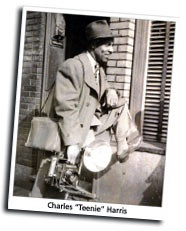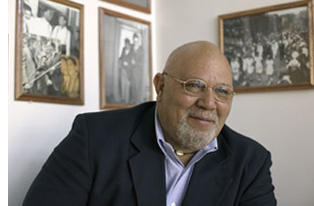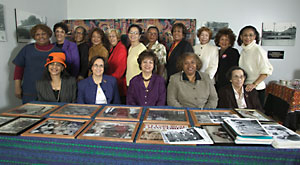 Filling in the Blanks: Filling in the Blanks:
The
Teenie Harris Archive
Project Continues
By
Ellen S. Wilson
"This
was the first exhibition that I’ve ever done
that had no labels,” says Louise Lippincott,
curator of Fine Art at Carnegie Museum of Art. “That
was deliberate, because we wanted to encourage people
to come in and fill in the blanks. And they did. We’re
beginning a dialogue instead of a lecture.”
Charles "Teenie" Harris was the principal
photographer for the Pittsburgh Courier from 1936 to
1975. Considered together, his photographs of special
events as well as day-to-day activities constitute
one of the most important records of 20th-century African
American life. The approximately 80,000 photographic
negatives in the Harris archive, however, which Carnegie
Museum of Art acquired in 2001, are largely unidentified.
The ongoing purpose of the Teenie Harris Archive Project
is to gather information about the people, places,
and events shown in the photographs.
“The research and the work on this collection
have to happen out in the community,” says Lippincott. “The
show was a pilot project, an attempt to discover if
displaying the photographs was a useful way to get
information, and it was.” Now, through various
channels, that work is continuing outside the walls
of the museum.
One resource the museum has tapped is the phenomenal
memory and connections of John Brewer of the Trolley
Station Oral History Center in Homewood. Brewer began
his own collection of Teenie Harris photographs about
12 years ago, and is quick to debunk the “One
Shot” myth, a nickname given Harris based on
his apparent ability to take one photograph—one
great photograph—of any scene and move on.
 John
Brewer of the Trolley Station Oral History Center in
Homewood collects Teenie Harris photographs and has
been instrumental in helping Carnegie Museum of Art
identify many of the subjects in Harris’ images. John
Brewer of the Trolley Station Oral History Center in
Homewood collects Teenie Harris photographs and has
been instrumental in helping Carnegie Museum of Art
identify many of the subjects in Harris’ images.
Photo: Terry Clark
“He was given that name because of how quick
he was, but if you’ve seen the photographs
I’ve
seen—and I’ve seen thousands—you
realize there were many shots. He should still be
called ‘One
Shot,” because if he was in an environment
with a lot of politicians, a tight spot, he didn’t
have much of an opportunity for a picture. He wasn’t
the Post-Gazette photographer, for example. He couldn’t
ask them to wait a second.”
Brewer first met Lippincott in March 2003 at an exhibition
of Harris’ photographs at Manchester Craftsmen’s
Guild. “They were great photographs,” he
says, “but no one knew what was in them. There
was no real life or history to go with them.” As
an oral historian with deep roots in Pittsburgh’s
African American community—his father was the
first black school principal in the city—Brewer
was able to offer his assistance in identifying some
of the scenes and people shown in the photographs,
and in assembling groups who could shed more light
on the pictures.
One of the groups Brewer has brought to the Trolley
Station to study the photographs is The Girlfriends,
a group of prominent African American women whose
age range, Brewer says, would encompass the relevant
era. “At
their monthly meetings, we set up photos on a table
and just let them go. And they say things like, ‘Oh,
this is my father, he was a judge.’” The
Girlfriends includes such women as Elaine Effort of
KQV, Judge Cynthia Baldwin, and Winifred Tolbert, director
of Community Development for the Pittsburgh Pirates.
Of the 80,000 Harris negatives in the Museum of Art’s
collection, 4,000 will eventually be part of the archive
project. Those 4,000 images were selected from work
prints already in existence, and every month up to
300 of them are added to the Museum of Art’s
web site for study. In addition, the University of
Pittsburgh is putting about 500 of Harris’ photographs
on its Historic Pittsburgh site, and more opportunities
are being sought to display Teenie Harris’ photographs
throughout the city.
 Girlfriends,
pictured at right at a recent meeting, is a group
of prominent African
American women who
have volunteered to sift through and identify
as many Teenie Harris images as possible during
their
monthly meetings. Several of the members have
found friends and family members among the subjects. Girlfriends,
pictured at right at a recent meeting, is a group
of prominent African
American women who
have volunteered to sift through and identify
as many Teenie Harris images as possible during
their
monthly meetings. Several of the members have
found friends and family members among the subjects.
Photo: Terry Clark
Accessioning the negatives—registering and admitting
them to the Museum of Art’s permanent collection—is
another project altogether. Each one has to be
dusted, written up in a condition report, put into
an archival
sleeve, numbered, and given a descriptive title.
Any information on the image must also be transcribed
and
entered into a database. Scanning the actual images
will come later. For now, gathering information
about existing photographs is paramount.
While the photographs were on display in the Museum
of Art’s Forum Gallery, visitors were invited
to share their knowledge through “memory sheets” in
the gallery or by posting their comments on the museum’s
web site. More than 1,000 memory sheets were gathered
from the two sources by the time the photographs
were taken off display. Now, students of Dr. Laurence
A.
Glasco, a University of Pittsburgh history professor
and a member of the Teenie Harris Advisory Committee,
are following up on some of these memory sheets,
verifying the information provided and trying to
collect even
more.
Since last July, the museum’s own oral historian
for the project, Patricia Pugh Mitchell, has been meeting
with people at libraries, churches, and other gatherings
to elicit memories they may have of the photographs.
A Ph.D. candidate in history at the University of Pittsburgh,
Mitchell was coordinator of African American programs
at the Historical Society of Western Pennsylvania,
where she wrote Beyond Adversity: Teaching about African
Americans’ Struggle for Equality in Western Pennsylvania,
1750 – 1990. “That research took me out
into the community,” Mitchell explains, giving
her many contacts and sources of information for
the Harris project.
Some older residents are especially helpful in
identifying pictures. “You can put a book of the photographs
in front of them, and they rattle it off,” she
says. Mitchell interviewed Robert Lavelle in his office
on the Hill, where he has been the proprietor of Dwelling
House Savings and Loan for about 50 years. She was
also able to connect with Vivian Hewitt, one of the
first African American librarians hired by Carnegie
Library of Pittsburgh, who now lives in New York. “She
was absolutely fabulous,” Mitchell says.
In addition, Deborah Starling Pollard, the museum’s
community liaison, has been taking slides of the Harris
photographs to community groups and retirement centers
since last June, and often the people she visits see
familiar faces in the pictures. At the Christopher
Smith Senior Highrise in the Hill District, residents
identified a photograph of Chuck Cooper, a Duquesne
University graduate, who was the first black athlete
to enter the National Basketball Association (NBA).
And when Pollard put up a slide of two children with
Easter baskets standing in front of the YMCA on Centre
Avenue, one woman stood up and said, “Those
are my children!”
There is a certain urgency to gathering this information.
Brewer lamented the death last August of Frank
Bolden, a well-known reporter for the Pittsburgh
Courier
in the 1930s and ‘40s who became an unofficial historian
of black Pittsburgh. “Frank took a lot with him,” Brewer
said. “He had so much information. I could say
a word to him, and he’d go on for an hour
if he felt like talking to me. We have to connect
with
our ancestors through living people. We have to
get our people to open up.
“The Museum of Art holds our history in their
hands,” he
continues. “I think they’re doing an
excellent job, and only they can do what is necessary
to preserve
this collection. I appreciate the time made available
for people to see the collection. People need to
understand that the essence of who we are lies
within those pages.
Teenie captured that, sometimes good, sometimes
bad. A lot of stuff happened from 1936 to 1975.
By bringing
it out and allowing us to do what we do, the Museum
of Art has given the general public a much better
appreciation for where they came from, non-African
Americans as
well as African Americans.”
. . . . . . . . . . . . . . . . . . . . . . . . .
. . . . . . . . . . . . . . . . . . . . . . . . . .
.
. . . .
Help Document History
Help Carnegie Museum of Art identify Teenie Harris’ images.
Visit the Museum of Art’s website at www.cmoa.org/teenie/info.asp and view up to 500 of Harris’ photographs. Submit
your comments by completing an electronic memory sheet
and become part of the museum's permanent record about
Teenie Harris and his images. Your participation will
enhance the significance of the Teenie Harris Archive
for anyone interested in the history of Black urban
life in the United States in the 20th century.
Back to Contents |